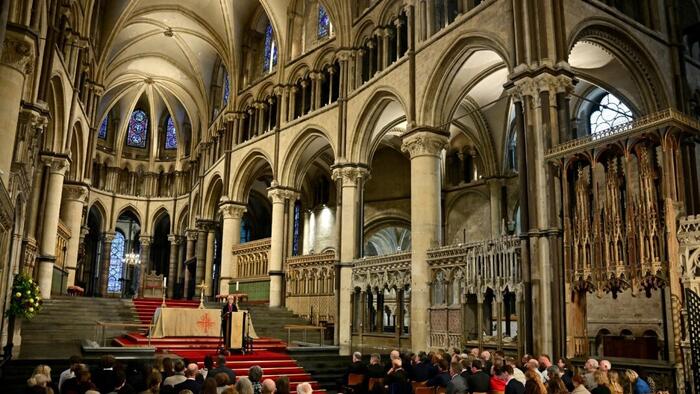


Authored by T.J. Muscaro via The Epoch Times (emphasis ours),
The decision to mark the walls of the UK’s historic Canterbury Cathedral with graffiti faced staunch international criticism on Oct. 10, as the Church of England’s attempt to appeal to marginalized communities has been criticized as ugly and inappropriate.
Titled “Hear Us,” the temporary art installation is set to open on Oct. 17 and remain open through January 2026.
Visitors will find graffiti spread across the walls and pillars of the 1,400-year-old cathedral as they would on the sides of city buildings.
The cathedral described the exhibit on its website as “the culmination of poet Alex Vellis and curator Jacquiline Creswell’s collaboration with marginalised communities and a team of skilled artists to create vibrant handwritten literature responding to the question ‘What would you ask God?’”
Questions chosen for the walls include “Are you there?” “Why did you create hate when love is by far more powerful?” and “Do you ever regret your creation?”
The cathedral acknowledged that some visitors have disapproved of the exhibit, noting that one deemed it “sacrilegious.” Yet it stood by the exhibit, with Dean of Canterbury David Monteith, chief resident cleric of Canterbury Cathedral, saying that the art “builds bridges between cultures.”
The criticism has gone international, attracting the ire of leaders regardless of religious affiliation.
U.S. Vice President JD Vance, a practicing Catholic, spoke out against it.
“It is weird to me that these people don’t see the irony of honoring ‘marginalized communities’ by making a beautiful historical building really ugly,” he wrote on X on Oct. 10.
Tesla CEO Elon Musk, who has described himself as a cultural Christian, replied to Vance’s post by simply saying, “Absolutely.”
Rev. Gavin Ashenden, a recent Catholic convert who once served as a chaplain to Queen Elizabeth II, also rebuked the exhibit.
“The way you ‘build bridges between cultures’ is by vandalizing superior accomplishments, then flattering the vandals by calling their work ‘raw,’ ‘disruptive,’ ‘unfiltered and not sanitized,’” he wrote on X.
Disciples of Christ, a self-described UK Christian protest group, also spoke out.
“This is sacrilegious,” the group posted on X. “Canterbury Cathedral has vandalised itself in the name of art. The Church of England needs reform. This disrespectful graffiti must be removed immediately.”
The exhibition is scheduled to close just before the official ceremony that will recognize Sarah Mullally as the 106th—and first female—archbishop of Canterbury.
Several voices on social media connected Mullally’s appointment and the graffiti installation as two signs of the same departure from the centuries-old traditions and beliefs of the church. Critics have called out Mullally’s liberal positions on LGBT issues, abortion, and immigration matters. They also pointed out that Monteith is an openly gay man and that Alex Vellis self-describes as nonbinary.
Mullally’s appointment alone led the Anglican Church of Nigeria to end its communion with the Church of England.
Catholic priest Rev. Dwight Longenecker, a former Anglican, said in a statement: “With the appointment of the feminist, ‘pro-choice’ Sarah Mullally as Archbishop of Canterbury and David Monteith, the partnered gay Dean of Canterbury ... the character of the Church of England of the twenty-first century is now formal and explicit.”
Rev. Ben Johnson, an Orthodox priest in the UK, contrasted the crude graffiti with reverent iconography.
“Canterbury Cathedral, founded by a 6th-century saint & now occupied by Sarah Mullally, covered its walls in graffiti for a Woke art project,” he said on X.
“The Orthodox Church’s proper iconography—of the sanctuary or the priesthood—has never been more important.”
